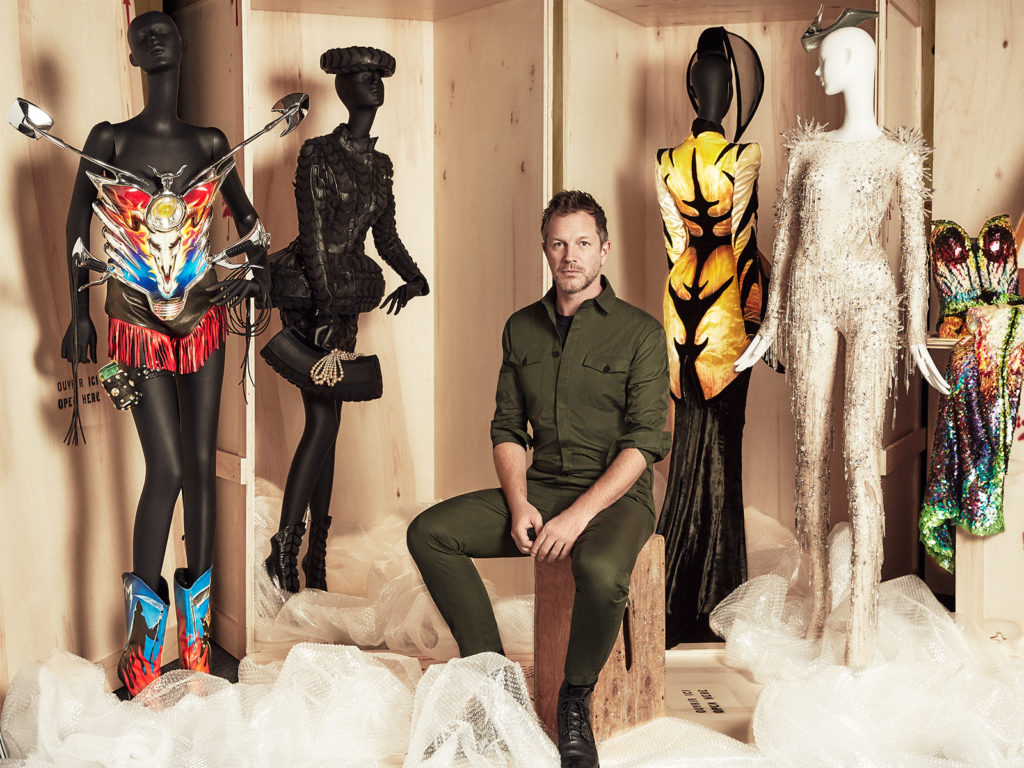
When it comes to celebrating homegrown fashion stars, it seems there are two paths a Canadian can follow to adulation: some heroes have outsized reputations (from Linda to Coco, only a first name is required). Others, like Thierry-Maxime Loriot, a visionary curator at the Montreal Museum of Fine Arts, fly under the cover of the mainstream while quietly shifting our culture toward the future.
For those who know, however, Loriot has garnered the reputation of a wunderkind, lauded for his unique ability to bring high fashion (in all its ephemeral glory) to life through dazzling career retrospectives of designers such as Jean Paul Gaultier and, most recently, Thierry Mugler. At 43, the curator is young to be making such a mark on an old-world institution—but Loriot isn’t interested in tradition. “I want to show that there are other things beyond just the garments,” he says, referencing his unconventional use of music videos, film clips, and multimedia elements. “There are so many layers that people can relate to, and then, whether through pop culture or craftmanship, they can see that there is incredible beauty that is made with fashion.” Equal opportunity appreciation is central to Loriot’s approach, which is why you’re more likely to find a Madonna video than an overwrought plaque in one of his shows. “I don’t make them for people from the fashion industry,” he says.
Case in point: his curatorial debut, 2011’s “The Fashion World of Jean Paul Gaultier: From the Sidewalk to the Catwalk”, was a journey through the couturier’s 35 years of provocation as told by animated, talking mannequin heads. The show was so popular that it subsequently toured 12 cities over the course of five years before inspiring a follow-up, “Love Is Love: Wedding Bliss for All à la Jean Paul Gaultier”, as well as exhibitions on designers Viktor & Rolf and photographer Peter Lindbergh.
Fast-forward to 2019 and Loriot is breaking records yet again with “Thierry Mugler: Couturissime”. The retrospective is centred around the iconoclast designer’s penchant for medium-shifting and features over 150 objects, including couture, costumes, sketches, and the legendary George Michael video, “Too Funky” which features a cavalcade of his wild pieces.
After refusing offers from other museums for years, the notoriously enigmatic Mugler sought out Loriot for the retrospective. “It was very difficult for me to believe that Mugler had picked me to do this exhibition,” he says. From the outside, though, it seems perfectly clear. The two Thierrys are alike in their theatricality and their penchant for shape-shifting (in addition to his curatorial efforts, Loriot has published nine art books and, last fall, led the creative direction on Rufus Wainwright’s tour).
He’s also a former model whose decade-long career alongside the likes of Mario Testino and Kate Moss was a full-on primer for his current gig. “I must say, I was not the most exciting model,” he says with a laugh. “I was very serious about everything. Modelling was more a way to discover a world that I was very curious about. I met fantastic art directors and worked with the most respected magazines and incredible people.”
Loriot returned to Montreal to study art history, eventually connecting with MMFA’s chief curator, Nathalie Bondil. “One thing that never helped me in the museum world was my good looks,” he says. “They were seen as a weakness.” She hired him anyway, initially as a research assistant, before enlisting him to help with an exhibit on John Lennon and Yoko Ono. Soon after, Loriot was given the chance to helm his own exhibit (Gaultier). The rest, as they say, is history. “Without the fashion world, I wouldn’t be able to create the product that I do now,” he says.
It’s no surprise that Loriot has fans in high places, something that was made clear at last spring’s Canadian Arts and Fashion Awards. There, he was awarded the Vanguard Award—after a congratulatory montage from Testino, Wainwright, and Suzy Menkes—while the Dutch design duo, Viktor Horsting and Rolf Snoeren surprised him onstage. The three creators have become close since working together on their retrospective and are currently working on a follow-up. “It’s very precious to be able to work with friends that get along so well,” he says.
“I think if you meet passionate or inspiring people, they can inspire you,” he says. In turn, he hopes to inspire others. “And that’s what the message of a fine art museum should be: to exhibit work that can inspire and excite everyone else.”

